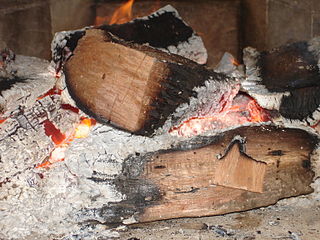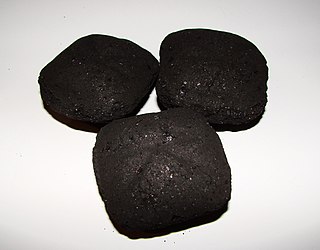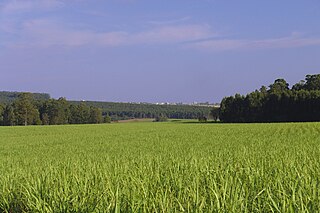
Combustion, or burning, is a high-temperature exothermic redox chemical reaction between a fuel and an oxidant, usually atmospheric oxygen, that produces oxidized, often gaseous products, in a mixture termed as smoke. Combustion does not always result in fire, because a flame is only visible when substances undergoing combustion vaporize, but when it does, a flame is a characteristic indicator of the reaction. While activation energy must be supplied to initiate combustion, the heat from a flame may provide enough energy to make the reaction self-sustaining.

Wood gas is a fuel gas that can be used for furnaces, stoves, and vehicles. During the production process, biomass or related carbon-containing materials are gasified within the oxygen-limited environment of a wood gas generator to produce a combustible mixture. In some gasifiers this process is preceded by pyrolysis, where the biomass or coal is first converted to char, releasing methane and tar rich in polycyclic aromatic hydrocarbons.

The pyrolysis process is the thermal decomposition of materials at elevated temperatures, often in an inert atmosphere.

Solid fuel refers to various forms of solid material that can be burnt to release energy, providing heat and light through the process of combustion. Solid fuels can be contrasted with liquid fuels and gaseous fuels. Common examples of solid fuels include wood, charcoal, peat, coal, hexamine fuel tablets, dry dung, wood pellets, corn, wheat, rice, rye, and other grains. Solid fuels are extensively used in rocketry as solid propellants. Solid fuels have been used throughout human history to create fire and solid fuel is still in widespread use throughout the world in the present day.

A briquette is a compressed block of coal dust or other combustible biomass material used for fuel and kindling to start a fire. The term derives from the French word brique, meaning brick.

Bioenergy is a type of renewable energy that is derived from plants and animal waste. The biomass that is used as input materials consists of recently living organisms, mainly plants. Thus, fossil fuels are not regarded as biomass under this definition. Types of biomass commonly used for bioenergy include wood, food crops such as corn, energy crops and waste from forests, yards, or farms.
Charring is a chemical process of incomplete combustion of certain solids when subjected to high heat. Heat distillation removes water vapour and volatile organic compounds (syngas) from the matrix. The residual black carbon material is char, as distinguished from the lighter colored ash. By the action of heat, charring removes hydrogen and oxygen from the solid, so that the remaining char is composed primarily of carbon. Polymers like thermoset, or most solid organic compounds like wood or biological tissue, exhibit charring behaviour.
Pyrolysis oil, sometimes also known as bio-crude or bio-oil, is a synthetic fuel with limited industrial application and under investigation as substitute for petroleum. It is obtained by heating dried biomass without oxygen in a reactor at a temperature of about 500 °C (900 °F) with subsequent cooling, separation from the aqueous phase and other processes. Pyrolysis oil is a kind of tar and normally contains levels of oxygen too high to be considered a pure hydrocarbon. This high oxygen content results in non-volatility, corrosiveness, partial miscibility with fossil fuels, thermal instability, and a tendency to polymerize when exposed to air. As such, it is distinctly different from petroleum products. Removing oxygen from bio-oil or nitrogen from algal bio-oil is known as upgrading.

Fire-retardant fabrics are textiles that are more resistant to fire than others through chemical treatment of flame-retardant or manufactured fireproof fibers.

Biochar is the lightweight black residue, made of carbon and ashes, remaining after the pyrolysis of biomass, and is a form of charcoal. Biochar is defined by the International Biochar Initiative as "the solid material obtained from the thermochemical conversion of biomass in an oxygen-limited environment". Biochar is a stable solid that is rich in pyrogenic carbon and can endure in soil for thousands of years.

Biomass, in the context of energy production, is matter from recently living organisms which is used for bioenergy production. Examples include wood, wood residues, energy crops, agricultural residues including straw, and organic waste from industry and households. Wood and wood residues is the largest biomass energy source today. Wood can be used as a fuel directly or processed into pellet fuel or other forms of fuels. Other plants can also be used as fuel, for instance maize, switchgrass, miscanthus and bamboo. The main waste feedstocks are wood waste, agricultural waste, municipal solid waste, and manufacturing waste. Upgrading raw biomass to higher grade fuels can be achieved by different methods, broadly classified as thermal, chemical, or biochemical.

Biomass heating systems generate heat from biomass. The systems may use direct combustion, gasification, combined heat and power (CHP), anaerobic digestion or aerobic digestion to produce heat. Biomass heating may be fully automated or semi-automated they may be pellet-fired, or they may be combined heat and power systems.
A landfill fire occurs when waste disposed of in a landfill ignites and spreads. Two types of landfills fires are generally recognized – surface fires and deep-seated fires. Surface fires typically occur in underdeveloped countries that lack capacity to properly cover waste with inert daily and intermediate cover. Modern examples of such fires include the Deonar and Ghazipur Landfills in India, Cerro Patacon Landfill in Panama and the New Providence Landfill in the Bahamas.

Slash-and-char is an alternative to slash-and-burn that has a lesser effect on the environment. It is the practice of charring the biomass resulting from the slashing, instead of burning it. Due to incomplete combustion (pyrolysis) the resulting residue matter charcoal can be utilized as biochar to improve the soil fertility.

Carbon dioxide removal (CDR) is a process in which carbon dioxide is removed from the atmosphere by deliberate human activities and durably stored in geological, terrestrial, or ocean reservoirs, or in products. This process is also known as carbon removal, greenhouse gas removal or negative emissions. CDR is more and more often integrated into climate policy, as an element of climate change mitigation strategies. Achieving net zero emissions will require first and foremost deep and sustained cuts in emissions, and then—in addition—the use of CDR. In the future, CDR may be able to counterbalance emissions that are technically difficult to eliminate, such as some agricultural and industrial emissions.

Charcoal is a lightweight black carbon residue produced by strongly heating wood in minimal oxygen to remove all water and volatile constituents. In the traditional version of this pyrolysis process, called charcoal burning, often by forming a charcoal kiln, the heat is supplied by burning part of the starting material itself, with a limited supply of oxygen. The material can also be heated in a closed retort. Modern "charcoal" briquettes used for outdoor cooking may contain many other additives, e.g. coal.

Bioenergy with carbon capture and storage (BECCS) is the process of extracting bioenergy from biomass and capturing and storing the carbon, thereby removing it from the atmosphere. BECCS can theoretically be a "negative emissions technology" (NET), although its deployment at the scale considered by many governments and industries can "also pose major economic, technological, and social feasibility challenges; threaten food security and human rights; and risk overstepping multiple planetary boundaries, with potentially irreversible consequences". The carbon in the biomass comes from the greenhouse gas carbon dioxide (CO2) which is extracted from the atmosphere by the biomass when it grows. Energy ("bioenergy") is extracted in useful forms (electricity, heat, biofuels, etc.) as the biomass is utilized through combustion, fermentation, pyrolysis or other conversion methods.

This is an alphabetized glossary of terms pertaining to lighting fires, along with their definitions. Firelighting is the process of starting a fire artificially. Fire was an essential tool in early human cultural development. The ignition of any fire, whether natural or artificial, requires completing the fire triangle, usually by initiating the combustion of a suitably flammable material.

Climate-friendly gardening is a form of gardening that can reduce emissions of greenhouse gases from gardens and encourage the absorption of carbon dioxide by soils and plants in order to aid the reduction of global warming. To be a climate-friendly gardener means considering both what happens in a garden and the materials brought into it as well as the impact they have on land use and climate. It can also include garden features or activities in the garden that help to reduce greenhouse gas emissions through processes not directly related to gardening.
In fire and explosion prevention engineering, inerting refers to the introduction of an inert (non-combustible) gas into a closed system to make a flammable atmosphere oxygen deficient and non-ignitable.




















